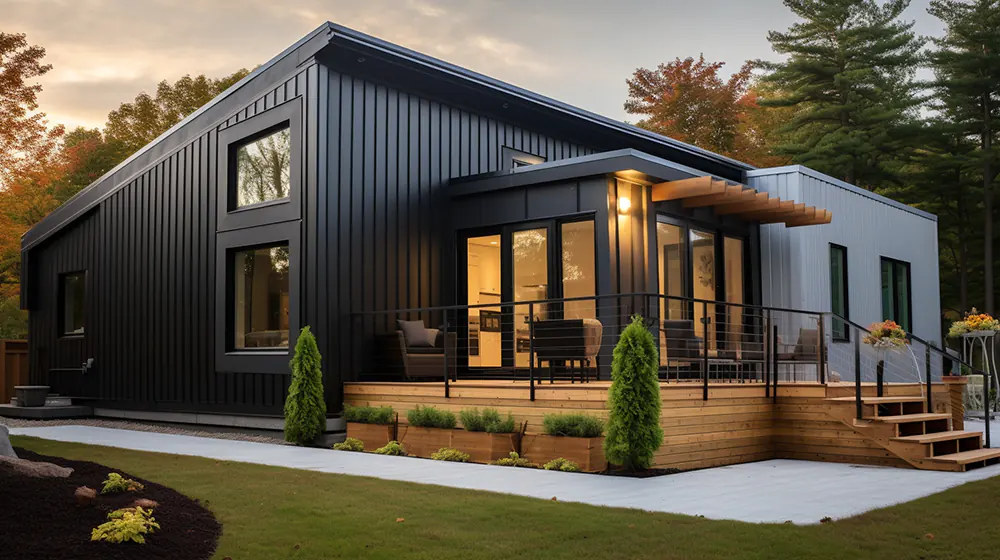Window and Siding Replac...
- Mon to Fri: 09:00 am to 07:00 pm

Have you ever wondered why vertical siding is becoming a trend in modern home designs? What makes it a preferred choice over other types of siding? Are you curious about the unique benefits it brings to the table? Or perhaps you’re interested in understanding the installation process? The following sections will delve into these questions, revealing why vertical siding is more than just a trend – it’s a smart and stylish choice for the modern homeowner.
Vertical siding, with its unique aesthetic and practical benefits, is gradually staking its claim in the world of architecture and home improvement. This blog post aims to delve into the ins and outs of vertical siding, from its advantages and disadvantages to its installation process and maintenance needs.
Whether you are a homeowner considering a facade revamp, or an architecture enthusiast keen on knowing the latest trends, this blog will provide an in-depth look into why vertical siding is becoming a popular choice. Additionally, we will explore how this siding style, inspired by the farmhouse style, can add a touch of rustic charm to any home or building, bringing warmth and character to your space. Join us as we uncover the beauty and functionality of vertical siding and discover why it’s more than just a trend.

Vertical siding refers to a type of wall cladding installed in an up-and-down direction, a stark contrast to traditional horizontal siding. This type of siding is commonly used in modern architectural designs to create a distinctive and dramatic appearance. Its linear pattern draws the eye upward, creating an illusion of greater height and offering a distinct aesthetic appeal.
Apart from its unique look, vertical siding is also known for its functional benefits, such as easy maintenance and superior weather resistance compared to its horizontal counterpart.

Vertical siding can be made from various materials, each offering unique aesthetic and practical qualities. Here are five common types:
Vinyl vertical siding is an affordable, durable, and low-maintenance material. This type of vinyl siding is highly resistant to weather changes and comes in a variety of colors.
Wood offers a classic, timeless appeal. However, it requires regular maintenance to prevent rot, insects, and weather damage.
Metal siding, usually made of steel or aluminum, is robust, fire-resistant, and requires minimal maintenance. It provides a modern, industrial look.
Fiber cement siding is a composite material that offers the look of wood but with higher durability and resistance to termites and rot.
Engineered wood provides the natural look of wood but with improved durability and resistance to weather conditions and insects.
Like any other architectural element, vertical siding comes with its own set of advantages and disadvantages. Let’s take a look at the pros and cons of vertical siding!

Visual Appeal: The vertical planks offer a unique aesthetic that can make your home stand out. Its linear pattern can make a building appear taller and more striking.
Durability: Vertical siding typically has a longer lifespan than horizontal siding. It’s less likely to suffer from water damage since rainwater can run off more easily.
Easy Maintenance: The vertical installation makes it easier to clean. Dirt and dust do not accumulate as easily as they do on horizontal siding.
Variety of Building Materials: Vertical siding comes in a variety of materials, including vinyl, wood, metal, fiber cement, and engineered wood, each with its own aesthetic and practical properties.
Weather Resistance: Vertical siding offers superior weather resistance. It’s less likely to buckle under heavy wind or to allow water to seep into your home.

Costly Installation: Requires furring strips for proper installation, which can increase the overall cost. Also, the installation process is more intricate and time-consuming than that of horizontal siding which is why many people hire a siding instalation team.
Higher Maintenance for Wood: While vertical siding is generally easy to maintain, wood siding requires regular upkeep to prevent rot, insect damage, and weather-related issues.
Style Limitations: Despite its uniqueness, this style of siding might not be suitable for all types of homes. It tends to be more popular in modern and contemporary designs.
Potential for Water Intrusion: If not properly installed, vertical siding can potentially allow water to seep in at the joints, leading to dampness and rot over time.
Less Common: Vertical siding is less common than horizontal. It might be harder to find a contractor near you familiar with its installation, and replacements might not be readily available.
There are a variety of siding styles, each offering something unique. From wood to vinyl, different materials can be used to create eye-catching patterns and a striking statement. Here are some popular examples:

Batten siding, also known as board and batten siding, consists of alternating strips of wider boards (batten) with narrower ones, creating a visually appealing pattern. This style is commonly used in country-style homes. Another popular variation is batten vinyl siding, which offers the same charming look with the added benefits of durability and low maintenance.

This style looks like overlapping boards and is often used to simulate the look of traditional wood siding. It also offers a subtle texture that can lend the facade an elegant touch. It’s important to note the difference between a horizontal lap and a vertical lap. A horizontal lap emphasizes the length of the boards, creating a classic and timeless appearance. On the other hand, a vertical lap adds height and can give a more modern and unique look to the design.

The tongue-and-groove joint creates a tight fit, which makes it suitable for homes in areas prone to severe weather. It comes in various colors and finishes, allowing you to customize the look of your home.

This style offers a wood-like appearance without requiring any maintenance. Unlike natural wood, this vertical siding does not need to be treated or stained over time.

This style of siding features interlocking boards that create a seamless look. Usually installed with a gap between the boards, shiplap offers a modern yet rustic aesthetic.
Yes, it can often be more expensive than horizontal siding due to the added labor involved in its installation when you hire a contractor. The cost can vary significantly depending on the type of material chosen, so it’s always advisable to obtain quotes from multiple contractors for a more accurate estimate.
Yes, vertical siding can be installed on nearly any type of building, from the home’s exterior to commercial buildings. However, it’s particularly popular in modern or industrial architectural designs due to its unique aesthetic.

The maintenance of the new siding largely depends on the type of material used. For instance, vinyl and metal siding require little to no maintenance, while wood and fiber cement may require regular painting or sealing to retain their appearance and durability.
Yes, it can give the illusion of a taller home by emphasizing its visual height rather than width. The linear pattern also helps to create a sense of grandeur and sophistication.
The cost of vertical siding depends on a variety of factors, such as the type and quality of material used, its size and complexity, and any additional labor or installation costs. Generally speaking, the cost can range anywhere from $3 to $12 per square foot. In most cases, it’s advisable to obtain quotes from multiple contractors for a more accurate estimate.
Gable accents are a popular siding style that features two rows of panels installed vertically, creating an angled or “v” shape. This style can lend the home a more modern appearance and is often used as an accent piece to break up long sections of horizontal looks. It’s also common on gable-ended roofs, hence its name.

Vertical siding offers a unique aesthetic appeal with distinct shadow lines that can enhance the architectural value of any building. Its durability and weather resistance make it a preferred choice for homeowners and builders alike. While the installation and maintenance cost might be high, depending on the material, the benefits it offers in terms of style, variety, and durability make it a worthwhile investment. Despite its variety of styles and materials, it’s important to remember that each has its own set of pros and cons.
Ultimately, the choice of vertical siding should reflect the homeowner’s taste, the architectural style of the house, and the local climate conditions. As homeowners alike continue to seek out solutions that combine aesthetics and functionality, vertical siding is set to maintain its popularity in the foreseeable future.
If you have any other questions please reach out by giving us a call, email, or contacting us directly on our site. we’d love to help answer any more questions or concerns you may have.

by Dan Dryer
September 11, 2023